

Twitter to remove harmful fake news about coronavirus. Twitter will remove tweets that run the risk of causing harm by spreading dangerous misinformation about Covid-19, the company has said, after weeks of criticism that its policies on misinformation were too lax.
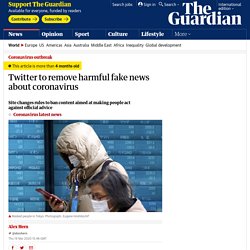
Now, the social network says, it will be applying a new broader definition of harm to address content that “goes directly against guidance from authoritative sources of global and local public health information”. According to Matt Derella and Vijaya Gadde, the heads of customer and legal, policy and trust and safety respectively, that means a whole range of content will now be removed that was previously allowed under the site’s rules, including: Unlike Facebook, which encourages users to actively report misinformation, Twitter doesn’t offer that as option for user flagging. Twitter has long been loth to introduce policies against misinformation, historically describing itself as the “free speech wing of the free speech party”.
Take on Fake. List of wines cited in lawsuit for having dangerously high arsenic levels - ViralServe. Lawyers are claiming that 28 California wineries bottled under 31 brand labels have extremely high levels of inorganic arsenic (one of the world’s oldest poisons, which is 500 times more toxic than the organic arsenic), to improve the flavor, smell and make the color more appealing.
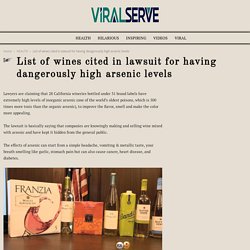
The lawsuit is basically saying that companies are knowingly making and selling wine mixed with arsenic and have kept it hidden from the general public. The effects of arsenic can start from a simple headache, vomiting & metallic taste, your breath smelling like garlic, stomach pain but can also cause cancer, heart disease, and diabetes. This is the full list: (4) Why Do Our Brains Love Fake News? Fake or Misleading News - Evaluate Your Sources Using the CRAAP Test - Research Guides at Modesto Junior College Library. The godfather of fake news. English Language Arts and Literacy, Science, Health and Physical Education, Engineering & Technology. Ever have an argument with someone, and no matter how many facts you provide, you just can’t get that person to see it your way?
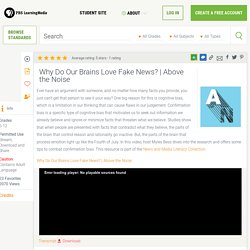
One big reason for this is cognitive bias, which is a limitation in our thinking that can cause flaws in our judgement. Confirmation bias is a specific type of cognitive bias that motivates us to seek out information we already believe and ignore or minimize facts that threaten what we believe. Studies show that when people are presented with facts that contradict what they believe, the parts of the brain that control reason and rationality go inactive. But, the parts of the brain that process emotion light up like the Fourth of July. Fact or Fiction? 8 TED-Ed Videos and a TED Talk to Show To Your Students. Wondering how to start the conversation with your students about fake news?
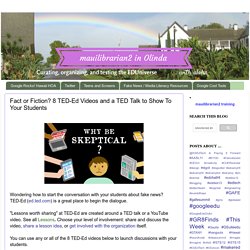
TED-Ed (ed.ted.com) is a great place to begin the dialogue. "Lessons worth sharing" at TED-Ed are created around a TED talk or a YouTube video. See all Lessons. Choose your level of involvement: share and discuss the video, share a lesson idea, or get involved with the organization itself. You can use any or all of the 8 TED-Ed videos below to launch discussions with your students. Note: The Think link will take you to a quiz and Dig Deeper has additional resources for study. Americans relying more on anecdotes than facts, which comes at a cost: study.
WASHINGTON, Jan. 16 (Xinhua) -- Americans' reliance on facts to discuss public issues has declined significantly in the past two decades, according to a report by U.S. global policy think tank RAND Corporation on Tuesday.

The phenomenon, known as "truth decay", is defined by increasing disagreement about facts, a blurring between opinion and fact, an increase in the relative volume of opinion and personal experience over fact, and declining trust in formerly respected sources of factual information, the report says. The situation is exacerbated by changes in the ways Americans consume information -- particularly via social media and cable news.
Other influences that may make truth decay more intense include political, economic and social polarization that divides citizens, the study says. It has led to damaging consequences, such as political paralysis and uncertainty in national policy, incurring real costs. The Psychology Behind Fake News. It’s hard to venture online these days—or switch on any cable network—without coming across a heated discussion over “fake news.”

Basic facts and figures, ranging from crowd sizes to poll numbers to whether or not it rained, now appear to be under negotiation. For many media consumers, it can feel as if we are living through an entirely new dystopian era, with each news cycle or press conference sending us further down the rabbit hole. 'Fiction is outperforming reality': how YouTube's algorithm distorts truth. It was one of January’s most viral videos.
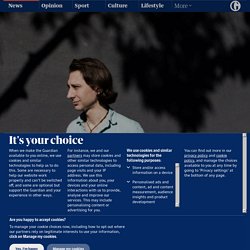
Logan Paul, a YouTube celebrity, stumbles across a dead man hanging from a tree. The 22-year-old, who is in a Japanese forest famous as a suicide spot, is visibly shocked, then amused. Junk News. Video Explores What Fake News Is and Isn't. How To Tell Fake News From Real News In 'Post-Truth' Era. Huge MIT Study of ‘Fake News’: Falsehoods Win on Twitter. Ultimately, they found about 126,000 tweets, which, together, had been retweeted more than 4.5 million times.
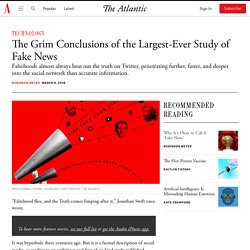
Some linked to “fake” stories hosted on other websites. Some started rumors themselves, either in the text of a tweet or in an attached image. (The team used a special program that could search for words contained within static tweet images.) And some contained true information or linked to it elsewhere. Then they ran a series of analyses, comparing the popularity of the fake rumors with the popularity of the real news.
S guide to fake news websites and what they peddle. At first look, BostonTribune.com certainly seems a trustworthy source. So does KMT11.com. And ABCNews.com.co. Even 24wpn.com has an official ring to it. Fake news? Bias? How colleges teach students not to be duped. Media literacy — some say media illiteracy — is having a moment.
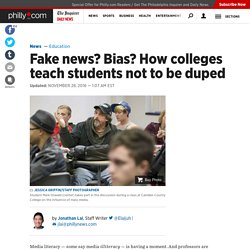
And professors are ready to respond. Advertisment 1 of 2. Students Create Website to Weed out Fake Accounts and Bots on Twitter. Two students have developed a way to detect fake news and bots on Twitter.
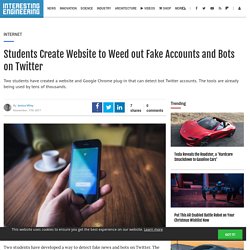
The news can’t come fast enough for millions of Americans who have recently discovered they may have been subjected to exposure to Russian paid ads and bot accounts created to deliberately interfere with the 2016 U.S. Federal election. The recent investigation into Russia's involvement revealed that more than $100,000 USD was spent by Russia buying ads on Facebook in order to influence voters towards Trump.
The two students have developed a website and Google Chrome plug-in called botcheck.me that can detect accounts on Twitter run by bots. These accounts usually have a very single-minded vision to influence followers to a particular train of thought. Popular Twitter account was actually Russia One great example is the popular Twitter account @Jenn_Abrams, which was discovered last week to actually be a Russian bot deriving from St Petersburg. Factitious.
Here’s a handy cheat sheet of false and misleading “news” sites — Quartz. Earlier this month, the California department of health released guidelines warning residents to avoid putting mobile phones up to their heads. “Keep your phone away from your body,” the state health department writes. “Although the science is still evolving, some laboratory experiments and human health studies have suggested the possibility” that typical long-term cell phone use could be linked to “brain cancer and tumors of the acoustic nerve,” “lower sperm counts,” and “effects on learning and memory.”
Mobile phones emit radiation, which is measured in radio-frequency (RF) energy. In the manual that comes pre-installed on your iPhone, Apple explicitly tells you to use a hands-free option like speakerphone or headphones while talking in order to “reduce exposure to RF energy.” The manual also notes that cell phones are currently tested for radiation assuming the devices would be kept at least 5 mm (0.2 in) away from the body while being carried.
Keep your phone away from your body. Facebook, Google and others join The Trust Project, an effort to increase transparency around online news. “Fake news” and other misinformation, online propaganda, and satirical content people believe is true have filled the web via search engines and social media, and have caused a rift in how people perceive today’s news organizations and the quality of their coverage. A nonpartisan effort called The Trust Project is working to address this situation by helping online users distinguish between reliable journalism and promotional content or misinformation. Today, a key part of that effort – called “Trust Indicators” – are going live on Facebook, offering easy-to-access, transparent information about a news organization’s ethics and practices. Here’s how this will work in practice: starting today on Facebook, an icon will appear next to articles in the News Feed.
Facebook, Google, Bing and Twitter have all committed to displaying these indicators, though not all implementations are yet live. These are as follows: 10 fact-checking sites to build students' media literacy skills. How To Detect Fake News With These Tools and Techniques. Top 10 sites to help students check their facts.
S guide to fake news websites and what they peddle. Can You Tell Fake News From Real? Study Finds Students Have 'Dismaying' Inability. The Problem with Fake News (and how our students can solve it)